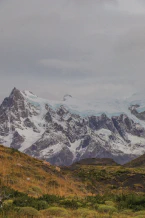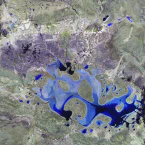Worlds Most Uninhabitable Places: A Journey

Our Beautiful Yet Harsh World: 10 Uninhabitable Places
Nature is a tantalizing enigma, showcasing beauty in its purest form while being brutally unforgiving. As adventurers and curious souls, it’s essential to understand the duality of our planet. Here, we’ll venture into ten of the world’s most uninhabitable places – regions that challenge human endurance, toughness, and audacity.
1. The Serpent’s Kingdom: Ilha Daquimara Granji
Picture a stunning 110-acre island off Brazil’s coast. But don’t be deceived by its allure; setting foot on Ilha Daquimara Granji, colloquially known as Snake Island, may be the last step you take. Ruled by an estimated one snake per 3.3 square feet, the island is dominated by the golden lancehead vipers, one of the world’s deadliest species.
2. Deceptive Beauty: Lake Neos
Lake Neos in Cameroon paints a serene picture. Yet, it conceals a perilous secret. Resting atop magma, its waters are saturated with carbon dioxide. In a tragic event in 1986, the lake released a massive cloud of CO2, suffocating nearly 1,750 people. While preventive measures have since been implemented, fears of potential disasters loom large.
3. A Haunting Echo: Whitnoom
Once bustling with miners extracting asbestos, Whitnoom now stands as a testament to the repercussions of ignorance. Despite the omnipresent blue asbestos – a deadly carcinogen – wafting in the wind, a brave few still call it home, defying the odds and potential health risks.
4. The Ever-Burning Town: Centralia
Centralia’s ghostly streets narrate a tale of underground fires that have raged since 1962, stemming from a dump fire. This fire’s persistent heat, spawning sinkholes and toxic fumes, has made Centralia a cautionary tale in the annals of mining history.
5. The Valley of Extremes: Death Valley
California’s Death Valley is a mesmerizing paradox. With scorching summer temperatures that have claimed many lives, it has truly earned its name. Yet, its beauty remains unparalleled. Adventurous souls must remember, however, that its winters also bring life-threatening chills.
6. Nuclear Shadows: The NNSS
The Nevada National Security Site (NNSS), a hub for nuclear tests between 1951 and 1992, remains a no-go zone. The toxic legacy of 1,021 detonations has rendered the water heavily contaminated. The presence of hazardous materials like plutonium ensures the area will remain uninhabitable for thousands of years.
7. Echoes of Chernobyl
Chernobyl’s name evokes images of the catastrophic nuclear meltdown in 1986. While parts of the Exclusion Zone are accessible for guided tours, it’s a stark reminder of humanity’s missteps. The area is predicted to remain uninhabitable for approximately 20,000 years.
8. Mars on Earth: Atacama Desert
The Atacama Desert, with its surreal landscapes reminiscent of Mars, is a haven for photographers. This parched land, one of the driest places on Earth, offers unique visuals but poses severe challenges to any potential inhabitants.
9. Antarctica’s Hidden Gem: McMurdo Dry Valleys
Antarctica, an unforgiving land of icy winds and extreme temperatures, conceals the McMurdo Dry Valleys. These valleys lack snow, not because of warmth but due to the sheer dryness. Yet, they represent only a fraction of Antarctica’s challenges.
10. Alien Landscapes: Danakil Desert
The Danakil Desert in Ethiopia is a realm of fiery extremes. Sulphuric hot springs, active volcanoes, and extreme temperatures coalesce to form a terrain that feels extraterrestrial. As explorer Wilfred Thessiger aptly put it, this is indeed “a land of death.”
While our planet is home to some of the most hospitable environments, these ten locations serve as reminders of the earth’s unpredictable and formidable nature. They inspire awe, respect, and an appreciation for the delicate balance that sustains life on Earth.
Conclusion
Our planet, in all its vastness and diversity, continues to astonish with its breathtaking vistas and compelling narratives of nature’s untamed spirit. While the ten locations outlined above highlight the earth’s more inhospitable and challenging terrains, they also serve as poignant reminders of the delicate balance that makes up our environment. These places, despite their inherent dangers, remain monuments of nature’s indomitable will and power. It’s an enthralling paradox: the very characteristics that render these locations perilous also imbue them with a raw, unparalleled beauty that draws us closer, compelling us to understand, appreciate, and respect their existence. In an age where modernity often overshadows nature’s wonders, such places stand as vigilant sentinels, reminding us of the inexorable forces that have shaped our world. Their tales of survival, toughness, and stark beauty underscore the importance of coexisting harmoniously with our environment. We, as global citizens, bear the responsibility of preserving these natural wonders for future generations. In doing so, we don’t just save these places; we preserve the rich tapestry of stories, lessons, and inspirations they offer. In the end, our world’s most challenging terrains urge us to look beyond the immediate and see the larger narrative – one of endurance, respect, and an ever-present quest for harmony between humanity and nature.
1. Are there any safe guided tours available to these places?
While some of these locations, like the Chernobyl Exclusion Zone, offer guided tours that adhere to safety standards, others are strictly off-limits due to their inherent dangers. It’s always crucial to conduct thorough research and consult with trusted agencies before embarking on any such adventure.
2. How have these uninhabitable places impacted local wildlife and ecosystems?
Many of these areas, especially those affected by human interventions such as mining or nuclear testing, have severely impacted local ecosystems. However, in some cases, the absence of human interference has allowed certain species to thrive, creating a unique biodiversity hotspot. It’s a complex interplay between nature’s toughness and the consequences of our actions.
3. Are there any preservation efforts in place for these sites?
Yes, many of these sites, particularly those of historical or ecological significance, have preservation initiatives in place. These efforts aim to minimize further damage, restore the natural balance, and ensure that future generations can learn from these poignant landmarks.
4. How do the inhabitants of these areas adapt to such extreme conditions?
Adaptation and toughness are at the core of human survival. Those who inhabit these harsh terrains have often developed unique lifestyles, skills, and even genetic adaptations to endure the challenges. From innovative housing solutions to specialized diets, their ways of life are testaments to human ingenuity and perseverance.
5. How can I contribute to the conservation and preservation of such areas?
There are numerous organizations and initiatives dedicated to the preservation and rehabilitation of these regions. Supporting them financially, volunteering your time, or even spreading awareness about these places and their significance can make a notable difference in their conservation efforts.






